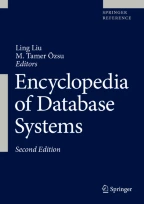Synonyms
Data warehouse design methodology
Definition
The term data warehouse life-cycleis used to indicate the phases (and their relationships) a data warehouse system goes through between when it is conceived and when it is no longer available for use. Apart from the type of software, life cycles typically include the following phases: requirement analysis, design (including modeling), construction, testing, deployment, operation, maintenance, and retirement. On the other hand, different life cycles differ in the relevance and priority with which the phases are carried out, which can vary according to the implementation constraints (i.e., economic constraints, time constraints, etc.) and the software specificities and complexity. In particular, the specificities in the data warehouse life-cycle derive from the presence of the operational database that feeds the system and by the extent of this kind of system that must be considered in order to keep the cost and the complexity of...
Access this chapter
Tax calculation will be finalised at checkout
Purchases are for personal use only
Recommended Reading
Demarest M. The politics of data warehousing. Retrieved June 2007 from http://www.noumenal.com/marc/dwpoly.html
Giorgini P, Rizzi S, Garzetti M. GRAnD: a goal-oriented approach to requirement analysis in data warehouses. Decis Supp Syst. 2008;45(1):4–21.
Jensen M, Holmgren T, Pedersen T. Discovering multidimensional structure in relational data. In: Proceedings of the 6th International Conference on Data Warehousing and Knowledge Discovery; 2004.
Kimbal R, Reeves L, Ross M, Thornthwaite W. The data warehouse lifecycle toolkit. New York: Wiley; 1998.
Jarke M, Lenzerini M, Vassiliou Y, Vassiliadis P. Fundamentals of data warehouses. Springer; 2000.
Golfarelli M, Rizzi S. Data warehouse design: modern principles and methodologies. McGraw-Hill; 2009.
Laender A, Freitas G, Campos M. MD2 – getting users involved in the development of data warehouse applications. In: Proceedings of the 14th International Conference on Advanced Information Systems Engineering; 2002.
Winter R, Strauch B. A method for demand-driven information requirements analysis in data warehousing. In: Proceedings of the 36th Annual Hawaii International Conference on System Sciences; 2003.
Hüsemann B, Lechtenbörger J, Vossen G. Conceptual data warehouse design. In: Proceedings of the 2nd International Workshop on Design and Management of Data Warehouses; 2000.
Abelló A, Samos J, Saltor F. YAM2: a multidimensional conceptual model extending UML. Inform Syst. 2006;31(6):541–67.
Theodoratos D, Sellis T. Designing data data warehouses. Data Knowl Eng. 1999;31(3):279–301.
Trujillo J, Luján-Mora SA. UML based approach for modeling ETL processes in data warehouses. In: Proceedings of the 22nd International Conference on Conceptual Modeling; 2003.
Vassiliadis P, Simitsis A, Skiadopoulos S. Conceptual modeling for ETL processes. In: Proceedings of the ACM 5th International Workshop on Data Warehousing and OLAP; 2002.
Golfarelli M, Rizzi S, Saltarelli E. Index selection for data warehousing. In: Proceedings of the 4th International Workshop on Design and Management of Data Warehouses; 2002.
Golfarelli M, Rizzi S, Turricchia E. Modern software engineering methodologies meet data warehouse design: 4WD. In: Proceedings of the 13th International Conference on Data Warehousing and Knowledge Discovery; 2011.
Hughes R. Agile data warehousing: delivering world-class business intelligence systems using scrum and XP. IUniverse; 2008.
Golfarelli M, Rizzi S. WAND: a CASE tool for data warehouse design. In: Proceedings of the 17th International Conference on Data Engineering; 2001.
Trujillo J, Luján-Mora S, Medina E. The gold model case tool: an environment for designing OLAP applications. In: Proceedings of the ACM 5th International Workshop on Data Warehousing and OLAP; 2002.
Francia M, Golfarelli M, Rizzi S. A methodology for social BI. In: Proceedings of the International Conference on Database Engineering and Applications; 2014.
Tho N, Tjoa A. Grid-based zero-latency data warehousing for continuous data streams processing. In: Proceedings of the 6th International Conference on Information Integration and Web Based Applications & Services; 2004.
Abelló A, Darmont J, Etcheverry L, Golfarelli M, Mazón JN, Naumann F, Pedersen TB, Rizzi S, Trujillo J, Vassiliadis P, Vossen G. Fusion cubes: towards self-service business intelligence. Int J Data Warehouse Min. 2013;9(2).
Author information
Authors and Affiliations
Corresponding author
Editor information
Editors and Affiliations
Section Editor information
Rights and permissions
Copyright information
© 2018 Springer Science+Business Media, LLC, part of Springer Nature
About this entry
Cite this entry
Golfarelli, M. (2018). Data Warehouse Life Cycle and Design. In: Liu, L., Özsu, M.T. (eds) Encyclopedia of Database Systems. Springer, New York, NY. https://doi.org/10.1007/978-1-4614-8265-9_117
Download citation
DOI: https://doi.org/10.1007/978-1-4614-8265-9_117
Published:
Publisher Name: Springer, New York, NY
Print ISBN: 978-1-4614-8266-6
Online ISBN: 978-1-4614-8265-9
eBook Packages: Computer ScienceReference Module Computer Science and Engineering
